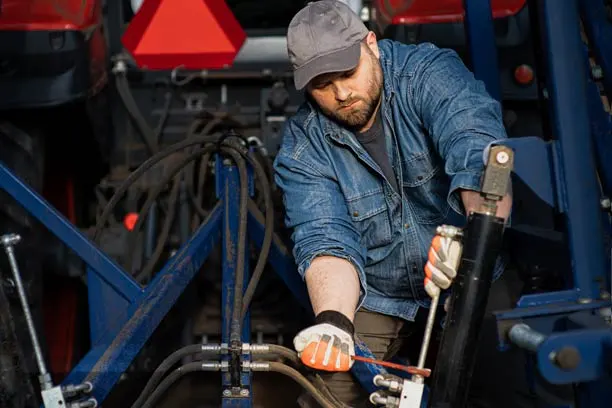How to Budget for Farm Equipment Repairs


When it comes to budgeting farm expenses, it may feel overwhelming to plan for breakdowns on large equipment. Here are six budgeting steps you can take to prepare yourself and your operation for breakdowns, either in season or planning for the next.
There’s no doubt that your farm equipment is expensive, and equally as expensive to repair or replace. Start by determining the Replacement Asset Value (RAV), which is the cost to replace the equipment with a new, similar model. This value helps in understanding the potential maximum repair costs.
Next, consider the expected lifespan of the equipment, which is the duration the equipment is expected to be operational before it needs replacement. This can be influenced by factors such as the quality of the equipment and how well it is maintained. Additionally, assess the usage of the equipment, including how frequently and intensively it is used, as higher usage typically leads to more frequent repairs.
By combining these factors, you can create a more accurate budget for repairs, ensuring that you allocate sufficient funds to maintain your equipment in good working condition.
Depending on where you purchased your equipment, you should have manufacturer guidelines that can help you establish farm equipment maintenance schedules. By adhering to these recommendations, farmers can prevent unexpected breakdowns and extend the equipment's lifespan. Regular service as per manufacturer guidelines ensures that minor issues are addressed before they escalate into major repairs, thereby optimizing repair costs.
Additionally, these agriculture equipment repair guidelines often include insights into common wear and tear parts, helping farmers anticipate and budget for equipment replacements. Incorporating manufacturer guidelines into the budgeting process allows for a more predictable and manageable approach to maintaining farm equipment.
By keeping detailed records of the maintenance history, you will have a good idea of what repairs you’ve made recently and what could break in the coming future. This historical perspective helps in anticipating potential issues and estimating costs accordingly.
However, it's crucial to factor in considerations such as inflation and the rising costs of parts and labor. Prices for replacement parts and repair services tend to increase over time, so adjusting the budget to reflect these trends is essential. Additionally, advancements in technology may lead to higher costs for newer, more sophisticated parts.
By incorporating these factors, farmers can create a more accurate and realistic repair budget, ensuring they are financially prepared for future maintenance needs.
You know that when something breaks down, it needs to be repaired. To budget for maintenance and repair, you can categorize your funds, starting with the most expensive farm equipment and breaking it down into further categories.
Maintenance funds should cover routine tasks such as oil changes, filter replacements, and regular inspections, which help prevent larger issues and extend the equipment's lifespan. These costs are generally predictable and can be scheduled based on manufacturer guidelines and past usage patterns.
On the other hand, major repairs require a separate allocation, as they involve more significant expenses like engine overhauls, transmission repairs, or replacing critical components. These costs are less frequent but can be substantial when they occur.
By distinguishing between maintenance and major repairs, farmers can ensure that they have sufficient funds set aside for both regular upkeep and unexpected, larger-scale repairs, maintaining the overall efficiency and reliability of their equipment.
Of course, it seems like equipment breakdowns happen when you need your equipment most. That’s why preventative maintenance is critical to keeping your equipment in top shape. These delays often result in additional costs, including the need for extra labor hours to catch up on missed work. The longer the downtime, the higher the labor costs, as workers may need to work overtime or additional staff may be hired temporarily.
Furthermore, delayed planting or harvesting can impact the quality and quantity of the produce, potentially leading to lower market prices and reduced revenue. To mitigate the risk of business interruption, it's essential to factor the potential costs of downtime into the repair budget. This includes setting aside funds for emergency repairs and considering the financial impact of delays and extra labor, ensuring that the farm can quickly recover from equipment breakdowns and maintain operational efficiency.
Farm owners should review their budget regularly to ensure it remains accurate and reflective of current conditions. Ideally, this review should occur quarterly to account for seasonal changes and unexpected expenses.
However, a monthly review can provide even more precise adjustments, especially during peak farming seasons when expenses and income can fluctuate significantly. During these reviews, it's important to analyze actual spending versus budgeted amounts, assess any deviations, and adjust future budgets accordingly. Factors such as changes in market prices, inflation, equipment wear and tear, and labor costs should be considered.
Regular budget reviews help in identifying trends, anticipating future financial needs and making informed decisions to optimize resource allocation and maintain financial stability. By staying proactive with budget adjustments, farm owners can better manage their finances and ensure the sustainability of their operations.
Utilize our annual farm planning checklist to help you organize your thoughts and schedule an on-site SuperCheck® with your local Farm Bureau agent to make sure your farm equipment is properly insured.